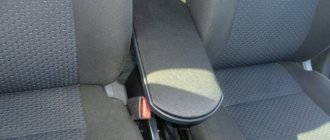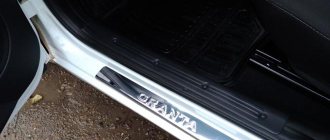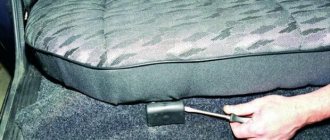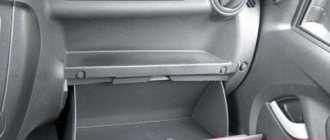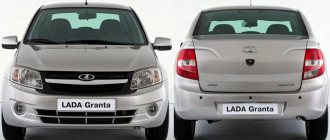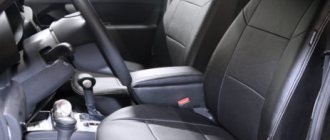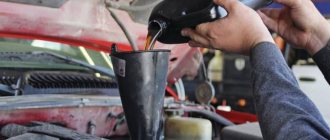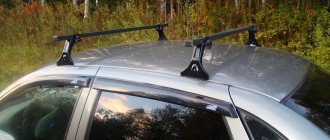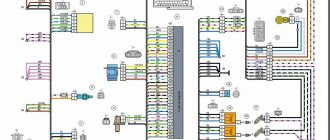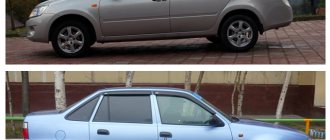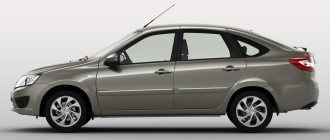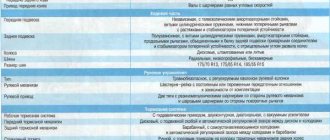Other analogues
p, blockquote 42,0,0,0,0 —>
The American analogue of Isofix is the LATCH system. The car has brackets for attaching car seats. The child seat has straps with carabiners that are attached to the brackets.
p, blockquote 43,0,0,0,0 —>
p, blockquote 44,0,0,0,0 —>
Thus, the main difference between the LATCH system is the movable belt connection with the child car seat. A higher degree of mobility during a collision increases the likelihood of a child's lateral movements and, accordingly, injury.
p, blockquote 45,0,0,0,0 —>
In practice, it is more convenient during installation and removal; in case of small impacts, due to its mobility, it compensates for the accelerating load.
p, blockquote 46,0,0,0,0 —>
In Canada, the UAS (Universal Anchorage System) standard is used, otherwise Canfix. It is also compatible with the Isofix system, but has a greater degree of movement than the European one.
p, blockquote 47,0,0,0,0 —>
Yamaha diversion 600 reviews
Pros Excellent ergonomics. Acceptable acceleration dynamics. Good brakes. Excellent handling at all speeds. Small price. Cons Noisy clutch operation. The motorcycle was produced only for European and…
At the beginning of winter I bought a child car seat. I spent a long time choosing different models, and eventually settled on INGLESINA Prime Miglia I-FIX, 1/2/3. In terms of price-quality ratio, it is an acceptable option.
I had to tinker with the installation. Isofix hinges are deep. It couldn't be inserted the first time, I had to press it into the seat. The seat belt anchor was located behind the back of the seat.
We drove all winter, my son is comfortable, so overall he’s happy.
Price tag: 13,360 RUR
Advantages and disadvantages of the Isofix system
Isofix has its pros and cons. Positive aspects include:
- convenient and simple fixation;
- no incorrect installation;
- ensuring reliable protection of children;
- minute montage.
One of the disadvantages is the presence of additional fasteners, which are not available in all salons. In addition, Isofix takes up a lot of space in the car. This is not always convenient. The system only works if the child weighs no more than 16-18 kg; in other cases, additional restraint is needed.
Attention! If you do not find fasteners for Isofix, contact a car service to install it. The procedure will take a few minutes
The fact is that in some machine configurations everything is provided for installation, but the fastenings themselves are missing.
Installing brackets yourself is quite difficult. In addition, the system is unlikely to meet the standards, and this is the most important thing!
How to install a child seat on a Lada Granta?
But no matter what the circumstances, you should not forget about the basic safety rules when installing a child seat; they will be useful both for parents using the Isofix system and for those who decided to make do with conventional seats secured with seat belts.
- Firstly, a child seat cannot be installed in the right front seat if the seat is equipped with an airbag and it is active. It is also prohibited for a child to sit facing the direction of the car (if the child’s body weight is more than 13 kilograms).
- Secondly, it is strictly forbidden for both the driver and passengers to hold children in their arms while driving, regardless of whether they are riding in the back or front seat.
- Thirdly, be sure to take into account the height and weight of the child when choosing a seat, especially if the child’s weight is less than 13 kilograms; there are a number of categories of child seats, the seller can always advise you on which.
- Fourthly, if the child’s body weight is less than 13 kilograms, the child seat cannot be positioned in the direction of travel.
Installation of the chair
Before purchasing a car seat, you need to check the car for the Isofix system. If it is not available, you will have to select a chair with an outdated fastening system. In some machines, Isofix is provided, but not supplied, and then it can be installed by contacting the dealer's service, but the service will not be free.
When the system is installed, there are grooves on the rear, and sometimes on the front, seats that are closed with plugs. They need to be removed and hidden so as not to be lost. The fasteners are aligned with the guides and move towards the back until it clicks. An “anchor strap” is attached to the top of the seat and secured to the back of the seat or to the trunk floor. If there is a support leg, adjust its inclination and height.
Removing the chair begins by pressing the latch lock, which prevents the fastener from falling out spontaneously, while the lock opens and the guides come out of the grooves. Then unfasten the “anchor strap”. The fasteners are closed with caps and folded, and plugs are inserted into the grooves to prevent debris from entering.
Tuning the interior of a Lada Granta car
Just recently, the Lada Granta car began to roll off the assembly line and could barely be found in car dealerships. The opening of free sales is scheduled only for April 2012, but already today skilled car enthusiasts and happy owners of a new car from the domestic automobile industry are beginning to embellish their car and make it different from the serial one. Tuning has also reached the Lada Grant.
In more detail, in the section we will look at tuning the Granta's interior, which is easiest to do on a new car without fear of losing the factory warranty.
One of the striking examples of such tuning is repainting the front panel of a car. Brighter colors fill the atmosphere of the interior space with a more expressive and pleasant feeling of being in it.
Read the manual for this salon tuning on the corresponding pages.
How to secure a car seat with ISOFIX in the car
Since there are many different models of ISOFIX car seats on the market, when installing, be sure to follow the instructions that came directly with the seat you purchased.
Of course, for the first time it will take some time, but once you understand the essence of the design, subsequent installation will not require much effort.
Contact a consultant at a car seat store for help, let him explain in detail to you the installation principle using the example of the selected model, or ask him to help you properly secure the device in the interior of your car.
The principle of attaching car seats with ISOFIX is approximately the same:
Carefully inspect the joint between the seat and backrest, find the ISOFIX mounting brackets. Some varieties may be additionally equipped with metal guides for installing chair brackets, but this is not necessary. Remove the brackets from the chair and snap both components into place.
Pay attention to the correct fixation indicators; they should switch from red to green. Now secure the seat with the standard seat belt of the car itself and adjust its tension
To do this, the child car seat is raised and the belt is thrown over the back, passed through the guides marked in red and fastened in the usual way. Now you can sit your baby down and adjust the five-point harness to his size.
Draw your attention to! All plugs must be removed and stored in the glove compartment; at the end of the trip, they are returned to their place so as not to damage the upholstery. Watch a short video that will help you correctly and quickly install an anchor car seat in your car:
Watch a short video that will help you correctly and quickly install an anchor car seat in your car:
How to install the base:
- Place the base base on the seat, use the button to extend the fasteners, it is located in the front. Snap all the parts with brackets, if everything is done correctly, you will see that the indicators have changed color from red to green.
- Move the structure as close to the back as possible.
- Pull out the additional retractable floor rest, use the button to adjust the height, after which the green indicators should light up.
- Now install the baby car seat (cradle) on the base. You need to combine all the fasteners until you hear a click. Again, see if the green lights come on.
- Place your baby in a seat and adjust the seat belts.
- In order to remove the structure, there is a special lever on the back wall; pull it.
The presented video instructions clearly demonstrate the sequence of actions when installing a car seat with an ISOFIX base:
Get additional legal advice online by submitting your question at the end of the article.
Show what isofix looks like on a grant
Guys, show me what isofix looks like on a grant? What to hang the chair on?
Similar articles
18 comments on “Show what isofix looks like on a grant”
There are three fastenings on the rear shelf
Dmitry, what other shelf?
Well, I have a sedan in the back on a mounting shelf, isn’t that for children’s seats?
Evgeniy, take off these plastic masks and there are supposedly hooks under them
Dmitry, I just have Kalina. ) There's nothing on the shelf.
Evgeniy, in the back! Under the black plugs
Denis, I have Kalina. )
Evgeniy, People are asking about grants here.
Evgeny, I saw this for the first time when I picked up the car two months ago)
Denis, there are fastenings, but they are not on the shelf. From which I concluded that this is the case for everyone. It turns out that Grant is mounted on a shelf. But, I think, on the liftback it’s the same as on Kalina.
Denis, and Granta is the same Kalina, if that. Only the body is different.
These are Met hooks, they are located on the back at the bottom, you can put your hand in and feel
So on all grants, regardless of the model
A child seat should also fit under this mount. If there is no such thing on the chair, then it is attached as usual through a belt
Isofix are two brackets screwed to the back of the seat, but there is a photo of their location, lift the rear seat and you will see them. And the fact that on the Grant there is a sedan on the rear shelf where the anchors are, this is not an easy-fix, this is a different standard for securing a child seat!
I have both isofix mounts on my Grant, anchor ones on top where the shelf is behind the rear seat and at the bottom at the base of the seat back there are loops for inserting a chair there.
I spent half a day looking for isofix staples on the grant - they are hidden under the upholstery of the back of the rear sofa, above them there is a slot in the upholstery...
I have both isofix mounts on my Grant, anchor ones on top where the shelf is behind the rear seat and at the bottom at the base of the seat back there are loops for inserting a chair there.
Age groups
Classification by weight groups is generally accepted throughout the world, in accordance with ECE R44/04 standards, and corresponds to Russian GOST.
Group 0
The child's weight is less than 10 kg. Approximate age: from birth to 6 months. Installation method: sideways to the direction of travel.
Group 0+
The child's weight is less than 13 kg. Approximate age: from birth to 1 year. Installation method: facing against the direction of travel.
Group I
The child's weight is from 9 to 18 kg. Approximate age: from 9 months to 4 years. Installation method: facing the direction of travel (there are car seats of paired group 0/I, which can also be installed facing the direction of travel).
Group II
The child's weight is from 15 to 25 kg. Approximate age: from 3 to 7 years. Installation method: facing the direction of travel.
Group III
Child weight - from 22 to 36 kg Approximate age - from 6 to 12 years Installation method - facing in the direction of travel.
Manufactured child car seats may correspond to one or more weight groups. The most popular children's car seats are designed for children of the following age groups:
Child car seats group 0+
Designed for children from birth to 1 year (weighing less than 13 kg). They are installed facing the direction of travel, the child is secured with built-in internal belts. Often children's car seats of group 0+ are called carriers - they are relatively lightweight, have a carrying handle and can be used at home as a rocking chair. Some models can be installed on special bases that are mounted inside the car. This makes it easier to remove/install the carrier and, more often than not, improves safety. A group 0+ child car seat is the best choice for a newborn baby.
Child car seats group 0+/I
Designed for children from 6 months to approximately 4 years (weighing no more than 18 kg). They are installed facing the direction of travel first, the child is secured with built-in internal belts. When the child reaches approximately 18 months, the child car seat should be installed facing forward. They have an adjustable tilt angle to change sleep/wake positions. A child car seat of group 0+/I is the best choice for a child who is already 6 months old.
Group I child car seats
Designed for children from 9 months to approximately 4 years (weighing from 9 to 18 kg). They are installed facing the direction of travel, the child is secured with built-in internal belts. There are also models in which the baby is secured not with internal belts, but with a special safety table. They have an adjustable tilt angle to change sleep/wake positions.
Group I/II/III child car seats
Designed for children from 9 months to approximately 12 years (weighing from 9 to 36 kg). Installed facing in the direction of travel. A child up to a weight of 15 kg is secured with internal belts, which are then removed. There are also models in which the baby is secured not with internal belts, but with a special safety table. Older children (from 4 years old) are secured in a car seat with a standard car seat belt. Group I/II/III child car seats are often called universal - they are intended for children of a wide age range.
Group II/III child car seats
Designed for children from 3 to approximately 12 years old (weighing from 15 to 36 kg). They are installed facing the direction of travel, the child in the car seat is secured with a standard car seat belt. Most often, a group II/III child car seat has a backrest. But there are also so-called boosters that do not have a backrest.
Features of use for different chairs
Categories of car seats are divided not by age and height, but by weight. They produce combined models that transform and are suitable for several weight categories at once. The instructions for the device indicate the weight and approximate age of children for whom the chair is suitable.
Weight restrictions
Isofix is not suitable for children weighing more than 18 kg. The weight of the car seat itself should be no more than 15 kg. Only in these cases does the system completely absorb the impact force in an accident and provide the necessary safety. The fasteners may not be able to cope with a large weight.
If the passenger weighs more than 18 kg, Isofix can be used additionally to simplify the installation of the seat and secure it. But other fastenings should be selected as the main security system.
Cradle chairs 0 and 0+
0 - infant carrier for newborns and children weighing up to 10 kg, up to about one year old. The device is fixed in a horizontal lying position. It can be detached and used separately as a classic carrycot. Inside there is a soft wide fixing belt and additional protection for the newborn's head.
0+ - suitable for children weighing up to 13 kg, aged from 0 to approximately 1.5 years. The device is installed against the direction of travel. The child is positioned in a semi-lying position.
For groups 0, 0+ there is no built-in Isofix. A special base is used for them, thanks to which you can quickly remove the cradle from the car.
Group 0+/1 is a swivel car seat that can be placed both against and in the direction of travel. It transforms depending on the age of the child and is suitable for passengers weighing up to 18 kg. Isofix is already built into the base of the chair.
Category 1 with seat belts
Suitable for children weighing from 9 to 18 kg (approximate age 1-4 years, height above 78 cm). This model is suitable for a child who already confidently crawls and stands, and begins to walk. Children are fastened with a five-point seat belt. The brackets are mounted into the base of the chair; sometimes there are separate bases. The child rides facing forward.
Group of seats 2-3 (boosters)
Isofix cannot be installed in category 2, 3 car seats or booster seats. The device can be used for additional safety and to simplify installation of the seat in the car. It will securely fix the chair when you do not need to transport the child.
These categories have features:
- Group 2 is suitable for children from 15 to 25 kg, 3-7 years old. The device is equipped with an adjustable backrest and a standard seat belt.
- The combined 2/3 transforming model is used for children from 3-4 years old and weighing from 15 to 36 kg. The backrest is adjustable and removable to turn the device into a booster.
- A category 3 car seat or booster is a seat without a backrest in which the child is secured with standard seat belts. Suitable for children over 7 years old and weighing from 22 kg.
Mobile restraint devices are chosen for the booster. An Isofit mount would be a suitable option. It is designed for older children. Its locks only hold the weight of the seat, and the child is secured by a three-point belt that goes over the top.
Features of application
p, blockquote 25,0,0,0,0 —>
Isofix is used in child car seat groups 0+, 1 and 2/3. When transporting children weighing from 15 to 36 kg, such a fastening is an auxiliary device. The main load should be provided by the car's standard seat belts.
p, blockquote 26,0,0,0,0 —>
p, blockquote 27,1,0,0,0 —>
There are no seat belts in car seats of these groups. The child is fastened with the car's standard seat belt system.
p, blockquote 28,0,0,0,0 —>
p, blockquote 29,0,0,0,0 —>
It would seem, why then use Isofix mounts in this group of car seats? The fact is that in case of a side impact, it significantly reduces the lateral displacement of the child. In the event of a frontal collision, the child car seat moves along the Isofix mounting slide, accompanying the child until the standard seat belts begin to operate, providing “all-round protection” for the child.
p, blockquote 30,0,0,0,0 —>
In group 0+, Isofix is a two-component system consisting of a base on which the main fastening elements and a carrying cradle are located. These two components can be purchased separately if the design elements are standardized. In some models, when a child moves from one weight category to another, you do not need to change the basic system (for example, Maxi-Cosi).
p, blockquote 31,0,0,0,0 —>
p, blockquote 32,0,0,0,0 —>
The base can be made in various versions.
p, blockquote 33,0,0,0,0 —>
p, blockquote 34,0,0,0,0 —>
This is very convenient for parents of babies. The cradle is usually small in size and weight. In it, you can bring him into the car without waking up the child and, accordingly, take him out of it, without making complex fastenings.
p, blockquote 35,0,0,0,0 —>
A special feature of the design of groups 0 and 1 is that Isofix has built-in seat belts. Securing with standard car seat belts is not required. This places 100% responsibility on the Isofix design and, above all, on:
p, blockquote 36,0,0,0,0 —>
- mechanical fastening to standard car brackets;
- base-cradle mounting design;
- reliability of built-in seat belts;
- strength of the stop.
Therefore, you should purchase a child car seat only from verified official ones; a car seat can reduce the degree of protection of the child to zero.
p, blockquote 37,0,0,0,0 —>
In children's systems 0+/1, a more convenient rotating bowl is sometimes used, since older children prefer the forward location of the examination area, while the reverse location for caring for the child is more convenient for parents.
p, blockquote 38,0,0,0,0 —>
The presence of a 3rd support point is mandatory for group 1 according to ECE R44/04 regulations, since during a frontal impact enormous forces are applied to the car seat. Some designs, such as the Romer Versafix, do not have additional support.
p, blockquote 39,0,0,0,0 —>
This is compensated by a special movable structure that redirects the impact force downward, that is, to the standard structure of the car seat. But such a child car seat cannot be installed on all cars equipped with the Isofix system.
p, blockquote 40,0,0,1,0 —> adsp-pro-2 —>
It is necessary to read the instructions supplied with the Romer Versafix, which contains a list of compatible car models. In general, you should carefully consider the purchase of a child car seat and its compatibility with the design of the car, since the question is about the safety of your child.
p, blockquote 41,0,0,0,0 —>
General instructions for installing ISOFIX brackets on the front passenger seat
If you plan to install the ISOFIX mount yourself on the front seat of your car, then below are general instructions on how to do this.
1) Purchase an ISOFIX bracket for your car model. The list of developed brackets can be found here.
It is important to understand that the ISOFIX bracket is a car part responsible for the safety of your Child in the event of an accident. According to the road transport safety standard, the brackets must be guaranteed to support a weight of up to 32 kg (including the car seat) at a peak load of 50 km/h. The ISOFIX brackets developed by our company are factory-fabricated from steel with a thickness of 3 mm and exceed the safety margin of the standard by several times.
2) Remove the front seat from the car. To do this you need to: – move the seat as far back as possible, unscrew the 2 bolts; – move the seat forward as much as possible and unscrew two of the same bolts from behind the seat; – under the seat, disconnect the electronics chips (terminals), preferably first the heating and electric drive (if any), and lastly the airbag (usually the yellow wire); – in rare cases, it is necessary to unlatch the buckle of the car’s standard seat belt.
Example of electrical terminals for the front seat RENAULT KAPTUR
3) Place the removed seat on a comfortable, flat surface with the bottom up so that there is easy access to the back wall of the backrest and the side plastic pads.
4) “Try on” the ISOFIX bracket to the seat. To do this, you need to insert the bracket with square brackets at the back of the seat into the gap between the backrest and the seat. This fitting will intuitively tell you whether it will be necessary to remove the side plastic linings (in 90% of cases the linings will have to be removed).
Trying on the bracket on a SKODA OCTAVIA A7 without removing the side trims, attaching to the metal bottom of the seat with pre-drilling holes
5) If the bracket is designed for fastening to the load-bearing frame of the metal seat frame, it is necessary to provide access to the fastening elements. As a rule, these are either bolts holding the base of the seat back, hidden behind plastic covers, or bolts on guides that are screwed to the car body.
Trying on the INFINITI QX60 ISOFIX bracket with the side plastic covers removed. Attaching to the backrest base bolts
6) Unscrew the bolts from the load-bearing frame. Insert the ISOFIX bracket with the lugs with pre-prepared holes for the bolts into the frame elements, and screw the bolts back. As a rule, the bolts sit in nuts welded into the frame. Sometimes it is necessary to replace the standard bolts with similar, but longer ones (included with the brackets), sometimes the bolts need to be additionally secured with nuts with bushings (also included in the kit).
INFINITI QX60 ISOFIX mount. The bracket is tightened with a bolt of the load-bearing frame
Keep in mind that each bracket comes with installation instructions, which clearly indicate how the ISOFIX bracket should be installed!
7) After installing the bracket, reassemble the chair in the reverse order. Congratulations, now your seat is equipped with one of the most reliable, safe and simple systems for securing children's car seats!
Installing a chair using the Isofix system
To install an Isofix car seat, determine where the brackets are located in the car seat. Remove the plugs, if any. Pull out the chair arms. Remove the caps here too. Insert the brackets into the connectors. It will click and the indicator will turn green. Secure an additional anchor point.
"Emphasis down"
The chair contains a special support that extends and is installed in the floor of the car. Due to it, the device will not roll over in a collision. This installation method is reliable and versatile. Not every car brand is equipped with an anchor mount, and the anchor can be purchased separately and adjusted to the height of the seat.
"Fastener-anchor"
Located at the top rear of the chair. The end is equipped with a carbine mount. It must be secured to a bracket located in the trunk or on the back of the rear seat of the car. You can find this place by a special anchor icon. The anchor fastening secures the top of the seat, which prevents the passenger from sharply tilting forward during a collision.
After installation, place the child in the chair and secure it with the internal straps. For more details on how to install the Isofix system, see the photo.
Similar systems
In the US and Canada, LATCH is used. On the side of the car seat, instead of metal brackets, there are belts with latches at the ends. The American design also simplifies the installation of the car seat and meets safety and quality standards.
The LATCH system is fixed at two points on the bottom and one on the top. The lower fastening is complemented by an anchor, which is passed under the headrest and secured to a loop on the rear parcel shelf or in the trunk.
Isofix mount in Lada Granta
Most likely we are talking about automatic folding of mirrors when arming, and not about folding in order to ensure injury safety.
His 5-year-old Granta looks quite decent, and if it weren’t for the paint “blisters” starting to appear on the hood lid, you would never say that there are more than 300,000 km on the odometer.
The answer to the question is simple. This is a strong steel bar hidden at the base of the back seat of the car. Usually the mount itself in the car is hidden behind plugs that are easily removed, and the mount becomes suitable for use.
The sedan is the longest in the family (4268 mm), given the love of Russians for this body, for our market it is a real classic of the genre. Liftback (4250 mm) is a cross between the version with a “tail” and a station wagon. The “car” (4118 mm), of course, is roomy, just right for summer residents.
The answer to the question is simple. This is a strong steel bar hidden at the base of the back seat of the car. Usually the mount itself in the car is hidden behind plugs that are easily removed, and the mount becomes suitable for use.
Lada Granta in configuration 0 is a “Standard” liftback with a 1.6-liter 8-valve gasoline engine producing 87 hp. and a manual transmission. Already this basic package has a good set of options.
Let us remind you that Lada Priora is the first car of the brand on which a driver's airbag is installed, regardless of the configuration. Recently, Priora received ISOFIX child seat mounts, and the front bumper was modified to meet European requirements for pedestrian protection.
From the first part of the review of used X3 F25s, we found out that the body remains in very good condition at 8-9 years of age, the suspension requires almost no attention, and the electrics are complex...
But don't despair if you have an old brand. You can safely transport children in seats without the ISOFIX system, but you need to approach the choice of a child car seat with all seriousness, and not run into a fake. It certainly will not provide your child with a safe ride, and can harm his health even in a minor collision.
The back row still allows you to get quite comfortable - there is enough space for both legs and head. The rear door cards have built-in audio system speakers.
There are two ways to install a child seat in the Lada Granta. The only difference is in the type of seat itself and how it is attached to the car.
Securing a child seat using standard seat belts
In order to install a child seat in the Lada Granta using seat belts, you only need one step - insert the tongue sewn into the belt into the lock with a black button. As soon as you hear a click, the action is performed correctly and your child is safe. However, it doesn’t hurt to check with your own hands whether the lock is latched and whether the belt is tightened tightly.
And yet, experts recommend choosing seats with the Isofix system, since it was developed specifically for Grant; the car interior is also equipped with all the necessary fastenings, which will help increase the level of safety of your child several times. And some parents even secure child seats using both the Isofix system and seat belts.
In addition, the quality of the chair itself plays an important role, which will not be improved by any methods of fastening, so when buying, the first thing you should pay attention to is the quality, you should not save on your child, and if the quality of the chair itself causes at least small questions, then it is better to refuse to buy it and spend a little more time looking for a better one.
How to use Isofix in a car
The isofix seat mounting system presents some complexity only at first acquaintance.
Before you begin installation, you need to find the mounting locations for the brackets. They can be located either completely openly or hidden behind plugs or decorative overlays with a symbolic image of a child seat.
Before installing the isofix mount, the plugs are removed. Then, pulling out the brackets with latches, insert them into the grooves. When doing this, be careful not to pinch the rear seat belt buckle or webbing.
Triggering is confirmed by a characteristic click, as well as a change in the color of the indicator curtain.
In most models of chairs, the brackets extend. This is done by rotating a special drum, moving the chair itself, pressing the corresponding lever, etc. Using the method specified in the instructions, move the chair towards the back of the seat until it stops. In this case, the latch buttons are blocked from accidental pressing. Chair installation is complete.
Features of fastening a chair up to 13 kg
The type of seats belonging to 0 or 0+ provide for placing the child in a removable cradle. To secure it in the rear seat, a separate base is provided.
The base has a folding support column, with which the isofix system fixes the seat in the rear seats at three points
The fixation of the latches on the brackets and the folding leg of the base, just as when attaching a regular chair, is confirmed by the appearance of a green curtain on the mechanism indicators.
The chair is placed on a fixed base. In this case, the child may already be in it. The latch is activated, after which the lever is turned, which also serves to carry the cradle. This will lock the latch, which will again be confirmed by the green indicator.
To remove the seat, you need to unfold the handle again, release the latch by pressing the special handle and remove the crib.
The video gives an idea of how to install the base:
Designs from 9 to 18 kg
This type of seat can be made with or without a base. In the second case, the anchor belt serves as an additional fixation of the chair. On one side it is attached to the back of the child seat, on the other it clings to a latch located at the headrest of the car seat, on its backrest, or in the luggage compartment of the car.
This video can tell you more about this:
https://youtube.com/watch?v=BTRXWxkVfVY
During sudden braking, including a head-on collision, the belt will prevent the seat from tipping over, even if the latches on the bottom cannot withstand the load.
Car seats from 9 to 36 kg
By law, the fastening of seats designed for such a child’s weight must be accompanied by additional fixation. As a rule, standard seat belts in the rear seat of the car are used for this.
It's easy to do. Once the isofix pins are engaged with the brackets, the chair is raised. The straps are wound behind the back, secured in locks and tightened, securely pressing the child seat to the seat.
Car seats from 15 to 36 kg
This type of seat belongs to the third load category. Along with the regular chairs, the installation of which we talked about above, this category includes the so-called “boosters”. This is a special type of child seat with isofix mountings for children whose height exceeds 95 cm.
Boosters are mounted on Isofix, without any additional devices. But the small passenger is insured using standard rear seat belts. The chair solves two safety problems:
- Insures the passenger against lateral displacement during an impact.
- Provides optimal positioning of the child's body relative to the seat belts designed for an adult passenger.
The second point is designed to prevent the child from “slipping” out of the belts, which often leads to tragic consequences.
How to comfortably carry two children with ISOFIX in the front seat
1. Installing the ISOFIX bracket on the front seat of your car.
Install the ISOFIX bracket on the front passenger seat. This solution will allow you to simply and safely install a car seat on the seat next to the driver, thereby freeing up space in the back seat for a second car seat and two adult passengers. This solution will also allow you to install three Isofix car seats at once without any problems.
Transporting children in the front seat in a restraint system does not violate traffic regulations and, if safety precautions related to airbags are followed, is a relatively safe way to transport a child.
The ISOFIX-MSK company provides services for installing ISOFIX brackets in the passenger seat in accordance with all the rules of the safety standard for children's road transport, and also sells brackets for self-installation. The cost of an ISOFIX bracket starts from 4,500 rubles, together with installation from 6,500 rubles, a list of developed models and exact prices can be found here (use filters by car brand), the installation time of the bracket, if available, is from 30 minutes.
2. Using ISOFIX-MSK or RiveMove rail brackets, which move car seats away from the standard ISOFIX anchorages
The ISOFIX-MSK bracket-rail is designed to increase the space between two isofix car seats in the rear seat, which allows you to place a third car seat between them, or comfortably accommodate an adult.
The ISOFIX-MSK bracket-rail is a metal structure consisting of an external metal body with ISOFIX locks (similar to those found in a car seat) and an internal frame with fastening loops according to the ISOFIX standard, which moves to the side by a distance determined by the clamps. The rail snaps onto the car's standard Isofix mounts, and the car seat snaps onto the rail itself.
Due to its design, the ISOFIX-MSK bracket-rails allow you to move one car seat to the side by a distance of up to 7 cm; two slats will allow you to expand the space in the middle of the rear seat between child car seats by a total of 14 cm.
Recommendations
Hi all! Please advise! No matter how many times I try to secure the child seats with Isofix, it still doesn’t work. The seats themselves are in the way. There are plastic guides. If it doesn’t work out, I’ll cut off the interfering cover and adjust the seat grants, I’ll have to rip it where it’s in the way. The safety of children is billions of times more important than the upholstery of a chair. Maybe there is a way to install it in a more civilized way. I've tried it 3 times already, the seats get in the way and the cover gets in the way. I haven't installed everything yet. Who resolved the issue?
As far as I remember, my guides were also difficult to fit. He pressed harder and eventually they climbed in. I spent a lot of time fiddling with the straps to secure them correctly.
I thought if Isofix, then you don’t need to secure the chair with belts.
need to. the back is attached to it
Then there is no point in overpaying for Isofix at all.
makes sense, 100%. With the straps the chair dangles like a dog's tail, but with the Isofix it stays firmly in place. Belts are an additional psychological protection; in principle, they don’t need to be attached. Fastenings for seat belts are needed only in case there is no isofix in the car!
need to. the back is attached to it
the backrest is attached with a “float”, which is thrown over the back of the chair and attached to the bottom behind the chair! Belts are just additional psychological confidence! ))
Quote from the instructions: “IMPORTANT: To install a child seat in a car, you MUST ALWAYS use Isofix connectors in conjunction with the seat belts, with the exception of the booster configuration...”
Is there an additional “float” at the back for fastening?
SOFIX (International Standards Organization FIX) is a child seat securing system developed by the International Organization for Standardization (ISO). It was designed to standardize all existing seat mountings and make them convenient and easy to install in a vehicle. One of the advantages of this system is that there is no need to use standard car seat belts. The child seat is attached directly to the car body using specially welded hinges.
Lada Granta is a modern car and therefore it also received the Isofix standard for fastening child seats.
This system includes two levers that have fixation points on the central and side places of the rear seats of the car, at the junction of the backrest and the cushion, and the points that attach the belt for child seats are located behind the rear seats. Pictograms for this system are provided on the lower part of the rear seat backrests on each side; the pictogram icons indicate the lower position of the child safety seat anchors.
To install “child seats” in a Lada Granta car using standard seat belts, you need to insert the tongue sewn into the belt into the lock, which has a black button; the action is done correctly if a clear click is heard.
Don't forget to check that the chair meets all international standards when purchasing. This will ensure your peace of mind and the safety of your child.
Seat with a specially designed system for Lada Granta
Perhaps the safest will be a seat that meets international standards, according to which a child seat cannot be fastened using standard seat belts, but instead will be attached to the body through specially welded hinges. Such a seat was developed especially for the Lada Granta; the fastening system is called Isofix. For this type of seat, the Lada Granta is specially equipped with fastenings at the bottom, as well as an upper safety belt, which will allow any parent to install the seat without problems. The disadvantage of the system is its high cost; as a rule, chairs with Isofix are 2.5 times more expensive than regular chairs, and not everyone can afford it. But the question is whether it's worth saving on your child's safety.
The system itself consists of two levers that have a fixation point on the central and side rear seats, at the very junction of the backrest and the cushion. And the points for attaching the child seat belt are located behind the car seats. Symbols indicating specific mounting locations are located on the bottom of the rear seats and on each side of the seatback.
All child seats are sold complete with very detailed instructions in written and schematic form, so that anyone can handle the installation. The only thing is that all the fasteners and marks are made so that they remain as invisible as possible in the absence of a child seat, so you won’t be able to find some the first time, and after installation you should carefully study the instructions again and make sure that everything is secured correctly.
During installation, special attention should be paid to the intersection of the Isofix brackets and the seat belts, as the brackets can cause severe damage to the belts.
What to do if your car doesn't have ISOFIX?
If you carefully read the instructions for your car, and the manufacturer claims that it is equipped with an ISOFIX system, but you cannot find it, then the solution can be very simple - it simply does not have brackets. In this case, you can simply contact the dealership and request their installation.
There are situations when a family has two cars (one is equipped with ISOFIX, the other is not) or in the near future it is planned to replace an old car without ISOFIX with a new modern model and parents are faced with a choice of which restraint device to prefer with or without ISOFIX. Our experts advise either choosing a very good car seat without ISOFIX or a device with ISOFIX, and removing the brackets from the car seat when using it in a car that is not equipped with a similar mount.
But don't despair if you have an old brand. You can safely transport children in seats without the ISOFIX system, but you need to approach the choice of a child car seat with all seriousness, and not run into a fake. It certainly will not provide your child with a safe ride, and can harm his health even in a minor collision.
You can find out which restraint devices are approved for transporting children, as well as what you need to pay attention to when choosing a child car seat, by reading the following article. Passive safety systems in cars are constantly being improved, especially for small passengers
One of them is the ISOFIX child seat mounting system. In this article we will tell you what it is, why it is needed and how it works.
Passive safety systems in cars are constantly being improved, especially for small passengers. One of them is the ISOFIX child seat mounting system. In this article we will tell you what it is, why it is needed and how it works.
Correct installation of a child seat in a car
Buying a child car seat is only half the battle. In order for it to truly protect the baby, and not just serve as a talisman against fines, it must be installed correctly. Unfortunately, sometimes difficulties arise with this. How to reliably tighten a seat belt, why the Isofix mount needs additional support and why turn the seat back forward - we understand the intricacies of transporting children in the car.
Installing an Isofix seat
If, when choosing a child car seat, you choose a model with Isofix locks, installation is noticeably simplified. But it doesn’t come down to just two clicks - even the simple and friendly Isofix mount has its own subtleties.
Any Isofix chair consists of the chair itself (bowl) and a base - an Isofix mount with a base mounted on it. This is convenient: the chair can be removed from the base for cleaning or rotated 180 degrees, while the base remains secured in the car.
The initial installation of an Isofix seat begins with searching for the mounting parts - metal brackets - in the back of the rear (in most cars - only the rear) seat. And this is not as simple a task as it might seem. For the sake of design, automakers disguise the brackets, hiding them with fabric plugs, or hiding them deep in the bowels of the seat. Feel the brackets with your hand to accurately determine where to install the chair; Isofix labels on the upholstery will help in the search. Latch inscriptions are also suitable - the American fastening standard is compatible with European Isofix chairs. But trying to secure a seat with an Isofix base with a standard belt (for example, in someone else’s car, where there is no Isofix mount) is absolutely prohibited.
Installation of an Isofix seat is performed in the following order:
- Pull the Isofix mounts out of the chair to their maximum length. This is usually done manually, and a lever is provided to unlock them at the front of the chair.
- Align the Isofix locks with the mating brackets in the car seat and push the seat towards the back of the seat until both locks click.
- Press the Isofix adjustment lever again and move the seat close to the back of the seat so that there is no gap between them.
- Make sure by the color indication that both Isofix locks are latched - the flags should be green.
- Adjust and secure the additional fasteners that the chair is equipped with: a telescopic support to the floor or an upper “anchor” strap.
Let's look at additional fasteners separately. The Isofix design requires another attachment point in addition to the two retractable locks. This is either a Top Tether or a telescopic leg at the front of the chair. They reduce the mobility of the chair and insure Isofix locks, which experience heavy loads in the event of an accident.
The Top Tether strap is attached to a metal clip on the back of the backrest and then manually tightened to allow for excess length. The telescopic support rests on the floor of the car, fixing its length with a built-in lock. Be sure to use the available optional seat fasteners to improve child protection.
Installing a Belt Seat
Compared to an Isofix seat, which requires appropriate fastenings, a belt seat is more versatile - it can be secured with a standard seat belt, which is found in any modern car. With one important caveat: only a three-point belt that has an upper diagonal strap. Installation of a child seat using a two-point “airplane” belt, which is found in buses and trucks, is not permitted.
Installing a belt seat is more difficult than Isofix, so carefully study the instructions and the belt routing diagram. Make sure that the belt fits strictly into the guides provided by the design of the chair, does not wrinkle or twist - the efficiency of its operation depends on this. After threading the belt, tighten it and secure it with clips on the body of the chair.
Face forward or backward
The child grows disproportionately: immediately after birth, the baby's head is significantly larger and heavier than the neck can support. This imbalance persists for approximately the first 15 months of life, and during this time - while bones and muscles are actively growing - the child can only be transported in a car backwards, so that an accidental nod of the head does not injure the neck. To achieve this, the chairs have the possibility of direct and reverse installation.
What to do if your car doesn't have ISOFIX?
If you carefully read the instructions for your car, and the manufacturer claims that it is equipped with an ISOFIX system, but you cannot find it, then the solution can be very simple - it simply does not have brackets. In this case, you can simply contact the dealership and request their installation.
There are situations when a family has two cars (one is equipped with ISOFIX, the other is not) or in the near future it is planned to replace an old car without ISOFIX with a new modern model and parents are faced with a choice of which restraint device to prefer with or without ISOFIX. Our experts advise either choosing a very good car seat without ISOFIX or a device with ISOFIX, and removing the brackets from the car seat when using it in a car that is not equipped with a similar mount.
But don't despair if you have an old brand. You can safely transport children in seats without the ISOFIX system, but you need to approach the choice of a child car seat with all seriousness, and not run into a fake. It certainly will not provide your child with a safe ride, and can harm his health even in a minor collision.
You can find out which restraint devices are approved for transporting children, as well as what you need to pay attention to when choosing a child car seat, by reading the following article
(5) Comments (0)
When choosing a car seat for a baby, many people ask the question - Which cars have an ISOFIX mount and how can I determine if I have Isofix?
Back in the 90th year of the last century, the International Organization for Standardization introduced a unified ISO standard for the Isofix system of fixation (fastening) of child car seats. Naturally, in the distant 90s, not all foreign cars had such a mount, let alone Russian cars.
This fastener is included in the basic equipment of foreign cars produced since 2006. Modern models of domestic cars are also equipped with this simple addition.
Which cars have Isofix?
Since 2006, Isofix fastenings have been installed in the basic configuration of cars. Since 2011, they have become a mandatory element for all cars produced and sold in the European Union.
The Russian auto industry has also recently been installing fasteners of international standard. They are present in cars produced later than 2011. For example, in Lada Granta, Lada Kalina cars.
Before purchasing a seat with Isofix, make sure that the mounting brackets are present in the car interior. They may not be indicated by a special sign or inscription, especially if the casing has been changed.
Check their presence by running your hand at the junction of the backrest and seat in the rear seat of the car. If necessary, remove decorative elements from the chair.
What to do if there is no fastening
For cars without Isofix mounting, you should purchase a car seat with standard fixation. But if you still want to use Isofix, contact a car service. The craftsmen will install the brackets into the car body. If necessary, they can also install mounts in the front seat.
"Leg" or "anchor"?
It turns out that International Standards require the design of car seats to have a leg element or Top Tether. They complement the Isofix mount. What is it and what should you give preference to when choosing a children's device? The thing is that the Isofix device itself is attached at two points to the seat of the vehicle. These two areas experience enormous load, since when an accident occurs, a torque is created. The “leg” or “anchor” is installed as a third fulcrum. It takes on part of the load and prevents the chair from moving forward.
The “leg” is a telescopic brace that extends from the front of the chair in the middle and rests on the floor. The Top Tether extends from the seat's headrest at the rear. It is attached with a carabiner to a bracket in the trunk of a vehicle. Depending on the car model, the bracket may also be located behind the seat headrest. The “anchor” is considered more convenient and versatile than the “leg”. Therefore, all new passenger cars will soon be equipped with Top Tether mounting brackets.
Installation options for child seats with Isofix
Isofix mounts provide only two fixation points. This is not enough. Therefore, a third support point is provided, which is performed in two versions:
- Emphasis on the floor . These chairs are equipped with a retractable support that is fixed to the floor of the car. This prevents the chair from tipping over during a strong impact and holds the chair securely.
- Top Tether anchor fastener . The “Top Tether” anchor type fastener is an additional fastener that is located behind the back of the chair. The location may depend on the design features of the car interior. It can be located on the trunk floor, on the rear backrest or on the ceiling. Usually the attachment point is disguised and can be found by the anchor icon.
ISOFIX anchor fastening
Floor support is considered a more versatile and reliable installation option. Not all vehicles are equipped with an anchor mount. The emphasis can be purchased separately, and can also be adjusted to the height of the seats.
Other analogues - Latch system
In the United States, the equivalent of Isofix is the Latch system. It is similar to Isofix, but has some design differences. Instead of rigid brackets, the Latch system uses soft straps with carabiners. They also attach to brackets in the seat. The result is not a rigid, but a movable coupling of the car seat. But Latch also has its winning sides.
Latch Mount
Advantages of the Latch system:
- elastic coupling produces less vibration;
- lighter weight of the car seat (about 2-2.5 kilograms compared to Isofix);
- maximum child weight for the Latch system is 30 kilograms;
- Each lock can be fastened separately, and not simultaneously as in Isofix.
- The American analogue is also compatible with Isofix. If desired, you can install both models.
Disadvantages of the Latch system:
- the movable mount is accompanied by a high risk in the event of a side impact;
- Latch chairs are expensive - there are no budget models;
- Seats can only be installed on the rear side seats;
- In Russia and the CIS countries, the Latch system is not as widely represented as Isofix.
Isofix is an international standard child car seat fastening system. Introduced by the ISO International Institute in 1990 (standard number: ISO 13216). Hence the name: ISO stands for International Standards Organization, and fix translates as “fastening”, “fixing”.
Isofix allows you to quickly and, most importantly, reliably install a child restraint system in your car. The mount consists of two autonomous parts. The first is metal brackets in the body structure (under the back of the rear seats), the second is metal retractable brackets at the bottom of the child seat. To install the chair, you need to connect these two parts together, that is, insert the latches on the brackets into the brackets.
Where to look for Isofix in your car?
If you are planning to purchase an Isofix restraint system for your baby, check whether your car has brackets for securing it. You need to look for them in the gap between the backrest and the seat of the rear seats. In some cars you can easily find the staples by just slightly pulling apart the upholstery, in others you will have to stick your hand deeper, as they may be “recessed” inside.
Description of the ISOFIX fastening system
Have you ever installed a child seat in your car? And if this is so, then many have problems with this - either the fastening belt has fallen into the wrong groove, or it has become twisted or loosely tensioned, and can no longer perform its intended function of protecting against emergency situations.
All these standard situations can be avoided if you use an improved method of attaching child car seats in your car using the ISOFIX system.
The seat will not tilt, move or come unfastened, since the design is very rigid and reliable, supplied in most brands of cars from leading European brands. And the design itself is an international standard for fastening seats for small passengers.
The principle of fastening is simple - on seats with the ISOFIX system installed, there are two small brackets located at the base, they allow reliable coupling with the main rear seat - they are simply snapped to the safety brackets, and the installation is ready.
How to install a child seat on a Lada Granta?
But no matter what the circumstances, you should not forget about the basic safety rules when installing a child seat; they will be useful both for parents using the Isofix system and for those who decided to make do with conventional seats secured with seat belts.
- Firstly, a child seat cannot be installed in the right front seat if the seat is equipped with an airbag and it is active. It is also prohibited for a child to sit facing the direction of the car (if the child’s body weight is more than 13 kilograms).
- Secondly, it is strictly forbidden for both the driver and passengers to hold children in their arms while driving, regardless of whether they are riding in the back or front seat.
- Thirdly, be sure to take into account the height and weight of the child when choosing a seat, especially if the child’s weight is less than 13 kilograms; there are a number of categories of child seats, the seller can always advise you on which.
- Fourthly, if the child’s body weight is less than 13 kilograms, the child seat cannot be positioned in the direction of travel.
